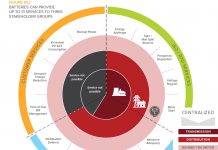Comparison of Energy Storage Technologies from Solar 2009
Tom Konrad, Ph.D.
A reader and CEO of a fuel cell startup sent me an email asking for a copy of my presentation comparing energy storage technologies which I referred to in last months article on Renewable Energy integration. Since other readers may be interested as well, here it is:
Economic Comparison of Electricity Storage Technologies (Power Point Show, 721 kb)
Here is also the spreadsheet where I gathered most of the data for the graphs. (Excel spreadsheet 74 kb)
Visual Comparisons
These following graphs can also be found in the spreadsheet and presentation. They all use the same data as the one in the renewable energy integration article, but display it on different axes. Larger bubbles to the top and right are more economic technologies.
I’m still looking for better data on the economic costs for HVAC based thermal storage, such as that sold by Ice Energy, and would appreciate any information from readers on this.
Tom Konrad, Ph.D.
In order to electrify transportation, well need batteries, with ultracapacitors and compressed air playing supporting roles. Based on cost, John has been making the case that the batteries for economical cars are more likely to be advanced lead-acid (PbA) than the media darling, Lithium-ion (Li-ion.) I generally agree, especially since recycling Li-ion batteries is an expensive and difficult process, although I see a future where both cars and oil are simply more expensive, and we have far fewer of them.
But transportation is only one application for energy storage technologies. Another is matching the electricity output of variable power sources such as wind and solar with demand, as well as providing standby power to accommodate sudden ramp-ups and ramp downs.
Storage for Grid-Tied Applications
Below is a chart I put together comparing the cost per kW (Power), cost per kWh (Energy) and Round-trip efficiency of a large range of technologies. Both axes are log scale. This slide will be part of a presentation I’ll be giving at Solar 2009 on May 15th. (I’ll also be on this panel on the 13th.) Technologies to the right can store energy cheaply, and are the best for matching variable energy output with demand. Technologies near the top deliver high power at low cost, and so are best for accommodating sudden changes in supply or demand on the grid. Larger bubbles represent higher round-trip efficiency, meaning that more of the stored power can be sent back to the grid.
There are many other important characteristics of storage technologies, such as cycle life, O&M costs, memory effects, response time, and size/weight, so the technologies which look best on this graph will not be the best for all applications.
Batteries: Mostly for Cars
It’s easy to note that lead-acid batteries dominate Lithium-ion batteries for grid tied applications: In a grid-tied application, the light weight of Li-ion batteries no longer makes any difference, and cost is much more important. More important, however, it’s also easy to note that neither the battery nor flow battery technologies are truly dominant in this context (note that I’ve lumped hydrogen electrolysis/fuel cell combinations (H2) with flow batteries in this context. The bubble hidden behind NaS is ZnBr, a Zinc-Bromide flow battery, being commercialized by ZBB Energy (ZBB).)
If I’d done this research a few years ago, I never would have recommended Vanadium Redox flow batteries (VRB) or Sodium Sulfur (NaS) in 2007, although a quick look at the chart makes clear why NGK Insulators (NGKIF.pk) is still selling NaS batteries while VRB Power declared bankruptcy not long after I sold it: NaS batteries produce much more power at the same cost. They also have the advantage (not shown here) that they are small enough to be moved, and so can be used to defer transmission and distribution upgrades in multiple locations over the life of the battery.
Lead Costs More than Salt, Water, or Air
When it comes to dealing with the large scale power for grid tied applications, the best technologies are the ones with the cheapest storage media. Thermal storage molten salt, while pumped hydro (PHES) uses water, and Compressed Air Energy Storage (CAES) uses air. Demand Response and Transmission do even better by shifting power use in time or space, and dispensing with a storage medium altogether.
The primacy of Demand Response and Transmission should not come as any surprise to regular readers, who will recall that Demand Response was the hero of the Texas Wind incident, while Transmission compares favorably to most storage technologies because it diversifies away many of the ups and downs of variable electricity supply and demand.
Pumped Hydro vs. Thermal Storage vs. CAES
Transmission is unfortunately difficult to permit and build, and demand response can only be used a few hours a year (at least until we get more responsive demand through smart grid investment.) This means that there will continue to be a large need for the three other forms of large scale, cheap energy storage. Unfortunately, all three can only be used effectively in special situations. Pumped hydro requires two adjacent reservoirs with a vertical drop between them, Thermal Storage works best with Concentrating Solar Power plants, especially in the tower configuration, and CAES requires an underground, air-tight cavern.
While reservoirs and caverns can be built, doing so erodes the economics of the technologies. It’s worth noting that the economics of pumped hydro vary widely depending on the location, and so the apparent advantage of CAES only holds in some cases; the locations of the bubbles are based on averages of the highest and lowest costs in the literature.
Investments
For investors who see opportunity in integrating renewable electricity into the grid, the media fascination with battery technology is an opportunity. They should focus on Demand Response and smart grid stocks such as EnerNOC (ENOC), Comverge (COMV), Itron (ITRI), Echelon (ELON), Telvent (TLVT), and RuggedCom (RUGGF.PK), Transmission stocks such as ABB Group (ABB), Quanta Services (PWR), General Cable (BGC), Pike Electric Corp (PIKE), ITC Holdings Corp (ITC), and Siemens (SI), before investing in traditional storage plays.
In many ways, this is fortunate, since Pumped Hydro, Thermal Storage, and CAES are all difficult for a stock market investor to get exposure to.
UPDATE: The full presentation comparing large scale energy storage technologies can be found here.
UPDATE 12/29/09- I came across better numbers for the cost of transmission, and updated the graphs here.











Hey Tom, when are you and John Peterson, and Charles going to start an ETF or mutual fund called “Energy TS&E”. T for transmission, S for storage, and E for efficiency. I guess you need an index first. I’m thinking Quanta, Amer Superconductor, Exide, Axion, Itron, Echelon, etc. There is no good one stop shop for this subsector. Sign me up.
Isaac,
I totally agree with the sentiment, these are big gaps in the avialble inventment products. Although it might be better to mix and match seperate storage, transmission, and efficiency ETFs.
However, when the mainstrema financial community catches up, and launches ETFs to fill these needs, it will probably be time to push on and find the next sector than no one is talking about and everyone should be investing in.
Tom, you have an error on the HVAC data. From your raw numbers, which I have, it is almost 10 times better than what you now show. Contact me.
Good stuff here none the less.
Thanks, for catching that, Mark.
The graphs and spreadsheet have been updated.
As I noted in the last paragraph, I was not able to get good data for HVAC based thermal storage… the numbers shown were a guess. I’m interested in your experience.
I’ll contact you via email.
Hi Tom,
I am CEO of start-up Trinity Thermal in the HVAC TES space. I’d be happy to provide some of the numbers you’re looking for.
Thanks Rick. I currently am working on other projects, but will contact you when I revisit electricity storage.
One technology not mentioned with the most potential to make a significant impact is storing energy in the form of heat using a phase change material such as developed by Elcal Research .check them out at elcalresearch.com
Greg-
The technologies show here are all commercial stage. There are actually a good number of non-commercial technologies that people have asked me to add to this, but I’m trying to keep it to an apples-to-apples comparison. The numbers here all come from existing commercial installations.